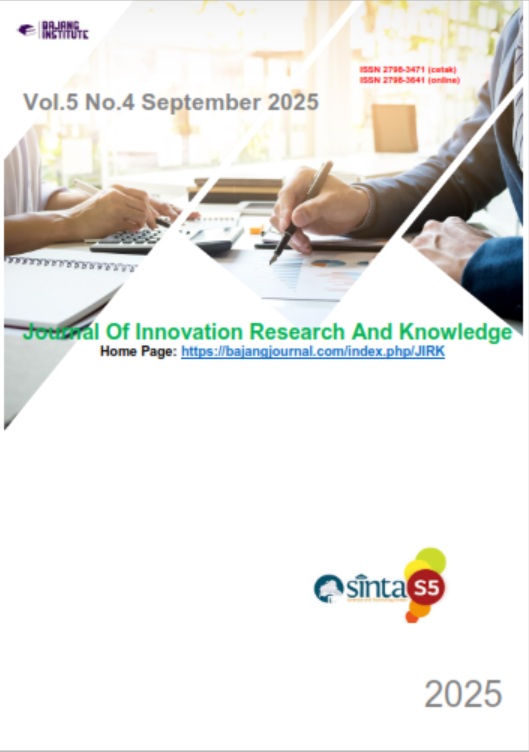PROSEDUR PEMERIKSAAN CT-SCAN KEPALA PEDIATRIC DI INSTALASI RADIOLOGI RSUD KABUPATEN TEMANGGUNG
DOI:
https://doi.org/10.53625/jirk.v5i4.11199Keywords:
CT-Scan, Pediatric, Age Classification, Scan Protocol, Radiation ProtectionAbstract
Background: Head CT scans performed at the Pediatric Radiology Unit of Temanggung Regency Hospital use the adult head protocol (Head Helical). This differs from the theory that specific head protocols are required for each age group. The purpose of this study was to determine the pediatric head CT scan procedure at the Radiology Unit of Temanggung Regency Hospital, the rationale for using the adult head CT scan protocol for pediatric head CT scans, and the radiation protection measures implemented during pediatric head CT scans. Methods: This study employed a descriptive qualitative method with a case study approach. Data were collected through observation, interviews, documentation, and literature review at the Radiology Unit of Temanggung Regency Hospital. Subjects included three radiographers and one radiation protection officer, with the pediatric head CT scan procedure as the object of the study. Data were analyzed through observation, interviews, and documentation. Interview results were transcribed and then summarized using a categorization table. The summarized data were presented in narrative form and explained with a theoretical basis to draw conclusions. Results: Pediatric head CT scans performed at the Radiology Department of Temanggung District Hospital used the adult protocol (Head Helical) without modifications based on age classification. Parameters such as tube voltage (120 kV) and current (300 mAs) were the same for infants and children, resulting in CTDIvol (78.1 mGy) and DLP values exceeding the BAPETEN IDRL standard. Although diagnostic imaging results were considered good, the risk of high radiation exposure remains a concern. Several reasons for the lack of protocol adjustments for pediatric head CT scans include: habit, timeliness, culture, and prioritizing good image quality. Radiation protection for patients and caregivers was implemented according to standards, including the use of aprons and educational procedures. Conclusion: The procedure was largely in accordance with theory from a technical and protective perspective, but the use of the adult protocol without adjustments increases the risk of overdose in pediatric patients. Periodic evaluation and implementation of pediatric-specific protocols based on the ALARA principle are strongly recommended for pediatric patient safety
References
Aslam, M. M. H., Shahzad, K., Syed, A. R., & Ramish, A. (2013). Social Capital and Knowledge Sharing as Determinants of Academic Performance. Journal of Behavioral and Applied Management, 15(1), 25–41. https://doi.org/10.21818/001c.17935
Ballinger, E. C., Ananth, M., Talmage, D. A., & Role, L. W. (2016). Basal Forebrain Cholinergic Circuits and Signaling in Cognition and Cognitive Decline. Neuron, 91(6), 1199–1218. https://doi.org/10.1016/j.neuron.2016.09.006
BAPETEN. (2020). Peraturan Badan Pengawas Tenaga Nuklir Republik Indonesia Nomor 4 Tahun 2020 Tentang Keselamatan Radiasi Pada Penggunaan Pesawat Sinar-X Dalam Radiologi Diagnostik Dan Intervensional. Peraturan Badan Pengawas Tenaga Nuklir Republik Indonesia, 1–52.
BAPETEN. (2020). Diagnostic Reference Level (DRL) dan Status Terkini di Indonesia. 80(1–3).
Bontrager, K. L. (2018). TEXTBOOK OF RADIOGRAPHIC POSITIONING AND RELATED ANATOMY.
Brenner, D. J. (2002). Estimating cancer risks from pediatric CT: Going from the qualitative to the quantitative. Pediatric Radiology, 32(4), 228–231. https://doi.org/10.1007/s00247-002-0671-1
Cahyati, Y., & Yusuf, E. I. (2022). Analisis Pengetahuan Perawat Rumah Sakit Terhadap Pentingnya Proteksi Radiasi Pada Saat Pemeriksaan Radiologi. Borneo Journal of Medical Laboratory Technology, 5(1), 341–347. https://doi.org/10.33084/bjmlt.v5i1.4436
Harwin, C. W., Milvita, D., Nuraeni, N., & Manzil, E. (2022). Evaluasi Proteksi Radiasi di Ruang CT-Scan Intalasi Radiologi Rumah Sakit Otak (RSO) DR. Drs. M Hatta Bukittinggi. Jurnal Fisika Unand, 12(1), 77–81. https://doi.org/10.25077/jfu.12.1.77-81.2023
Hiswara, E. (2015). Proteksi dan Keselamatan Radiasi di Rumah Sakit. In BATAN Press.
International Atomic Energy Agency (IAEA). (2006). Radiation Protection in the Design of Radiotherapy Facilities. IAEA Safety Reports Series No. 47. https://www-pub.iaea.org/MTCD/publications/PDF/Pub1223_web.pdf
Lampignano, John P., L. E. K. (2020). Textboook of Radiographic Positioning and Related Anatomy.
Long, B. W., Rollins, J. H., & Smith, B. J. (2016). Merrill’s Atlas Of Radigraphic Positioning and Procedures. In Elsevier.
Micheau, A. (2024). Normal Cranial CT Scan of the Cead: brain, bones of cranium, sinuses of the face. https://doi.org/https://doi.org/10.37019/e-anatomy/346546
Rao, P., Bekhit, E., Ramanauskas, F., & Kumbla, S. (2013). CT head in children. European Journal of Radiology, 82(7), 1050–1058. https://doi.org/10.1016/j.ejrad.2011.11.038
Romans, L. E. (2011). Computed tomography for technologists : a comprehensive text.
Seeram, E., & Sil, J. (2016). Computed tomography: Physical principles, instrumentation, and quality control. In Practical SPECT/CT in Nuclear Medicine. https://doi.org/10.1007/978-1-4471-4703-9_5Sherwood, L. (2011). Fisiologi Manusia dari Sistem ke Sel. Human Physiology: From Cells to System, 1–870.
Ummah, M. S. (2019). Bontrager’s TEXTBOOK of RADIOGRAPHIC POSITIONINGand RELATED ANATOMY. In Sustainability (Switzerland) (Vol. 11, Issue 1).
Wahyuni, S., & Amalia, L. (2022). Perkembangan Dan Prinsip Kerja Computed Tomography (CT Scan). GALENICAL : Jurnal Kedokteran Dan Kesehatan Mahasiswa Malikussaleh, 1(2), 88. https://doi.org/10.29103/jkkmm.v1i2.8097
Woroprobosari, N. R. (2016). Efek Stokastik Radiasi Sinar-X Dental Pada Ibu Hamil Dan Janin. ODONTO : Dental Journal, 3(1), 60. https://doi.org/10.30659/odj.3.1.60-66
Zainal, S. B. & arifin. (2015). Perbandingan Kualitas Citra Ct Scan Pada Protokol Dosis Tinggi Dan Dosis Rendah Untuk Pemeriksaan Kepala Pasien Dewasa Dan Anak. Youngster Physics Journal, 4(1), 117–126.













